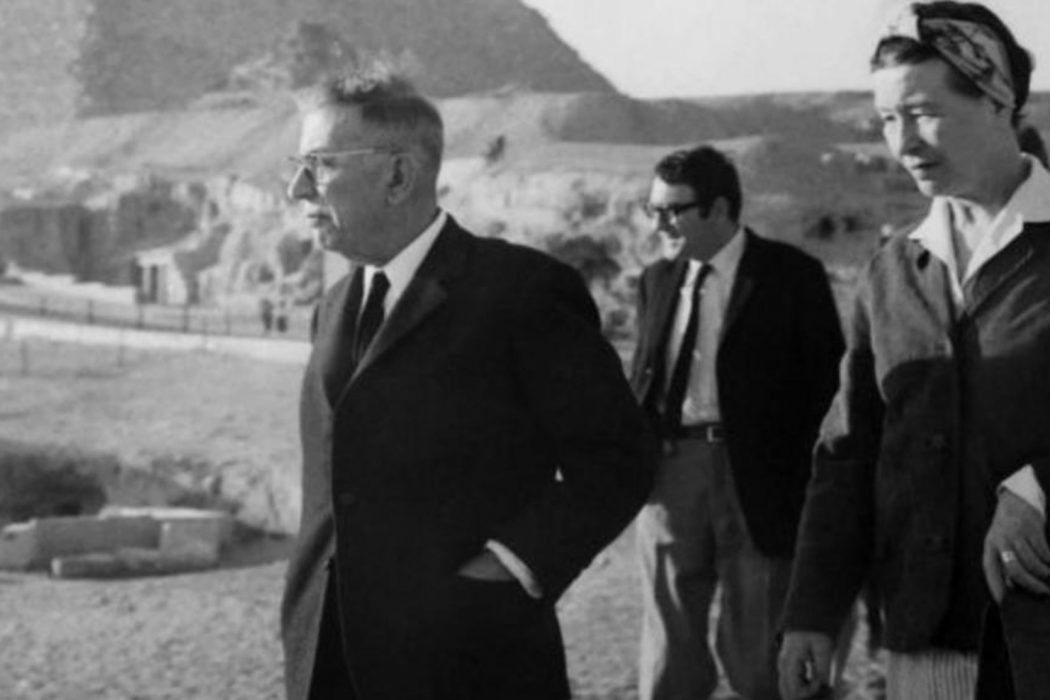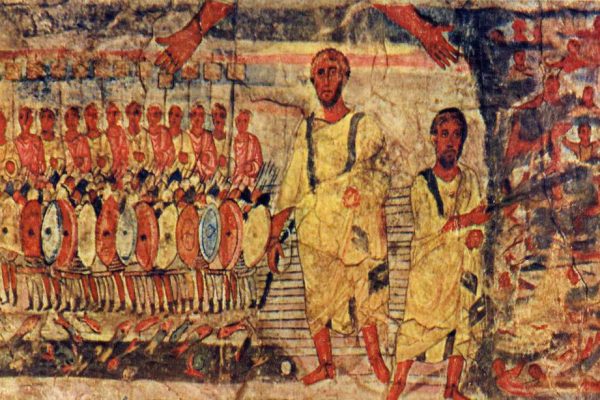Book Review: Manuela Consonni and Vivian Liska, Sartre, Jews and the Other, The Vidal Sassoon Studies in Antisemitism, Racism, and Prejudice, 2020
Abe and his friend Sol are out for a walk together in a part of town they haven’t been in. Passing a Christian church they notice a curious sign in front saying “$1,000 to anyone who will convert”. “I wonder what that’s about”, says Abe, “I think I’ll go in and have a look. I’ll be back in a minute, just wait for me”. Sol sits on a sidewalk bench and waits patiently for nearly half an hour, and then Abe reappears. “Well”, asks Sol, “what are they up to? Who are they trying to convert? Did you get the $1,000?” Indignantly, Abe replies. “Money. That’s all you people care about”. (Ted Cohen, Jokes, The University of Chicago Press, P. 27)
Edited by Manuela Consonni and Vivian Liska, Sartre, Jews and the Other is a monumental oeuvre comprising eighteen long essays written by a host of scholars from universities in the United States, Israel, France, Germany, and Italy (Bruno Chaouat, Thomas Connolly, Manuela Consonni, Yael Feldman, Vinzia Fiorino, Nina Fischer, Eva Illouz, Jonathan Judaken, Ethan Katz, Vivian Liska, Revital Madar, Renée Poznanski, Leonardo Senkman, Eli Schonfeld, Martina Weisz, Frédéric Worms, Dror Yinon and Joëlle Zask), all of whom have an original, situated perspective on Sartre’s famous Réflexions sur la question juive (1944).
As with most anthologies, this collection of proceedings from a conference held at the Hebrew University, is impossible to review without doing a great disservice to all its contributors: each article deserves a much deeper discussion, given the extremely wide range of topics covered, on the one hand, and the different attitudes the authors display vis a vis Sartre’s seminal text, on the other.
Despite the variety, there is one issue that runs through all the contributions. Namely, the paradox that lies at the core of Sartre’s Réflexions, in the third of the book’s four chapters: the one in which he analyzes “the Jew” and his/her condition, as opposed to that of “the Anti-Semite” (chapter one) and “the Democrat” (chapter two), the first being the Jew’s more or less outspoken enemy, the second being the Jew’s false friend on account of the abstract universalism with which he blithely dismisses the predicament that any Jew has to deal with, whether she cares to or not: “The democrat can thus only save the Jew as the incarnation of the universal, never save him in his particularity” (Judaken, p. 116).
This leads us to the next point (the paradox will have to wait a bit): no matter how she feels about her religion, kinship, culture, or whatever it is that constitutes her Jewish identity, the individual Jew is not allowed to forget that others perceive her as having that identity, portrayed with the derogatory traits we all know too well. As in the hyperbolic scene in Annie Hall (1977) where Woody Allen/Alvy Singer visits his gentile in-laws and envisions them seeing him as a black-cloaked, long-bearded Hasidic rabbi, being Jewish puts the individual in the uncomfortable position of being looked at as a member of a disparaged group. There is no escape, Sartre says: the moment she sets foot outside the house she has to decide whether or not she accepts the persona that has been cast upon her. And even if she does not accept it, she can’t just shrug it off as if it didn’t matter. The others won’t let her, even when they express sympathy or admiration for the superior intelligence that her group allegedly possesses (and we all know what a two-edged sword such a compliment really is). After all, love and hate are the two “symetrically contradictory” ways in which according to Sartre human beings may be reduced to objects and deprived of their liberty (Worms, p. 28). Crushed between the Jew-haters who despise her (as a Jew), the Jew-lovers who flatter her (as a Jew) and the Democrats who do not acknowledge her particular “being in situation” (as a Jew), she can only play the Jew, or refuse to do so, which is more or less the same. In any case she won’t be free from such externally produced cultural conditioning: “This is the tragedy of the modern Jew: whatever he does, so it seems, he is condemned to play a (tragicomic) role, to live his life masked, like the famous waiter described by Sartre in Being and Nothingness” (Schonfeld, p. 48).
 All the more so in 1944, of course. When Sartre wrote his book (one of the first to denounce Anti-Semitism in post-war France, as Weisz points out), Jewish identity had none of the glamorous connotations it has acquired over the past few decades, at least among the reflective, globalized middle-classes that now perceive Holocaust memory as the cornerstone of Western identity, and anxiously leaf through their family albums in search of some forgotten Jewish great-grandparent to display. At that time, most survivors had still to come back from the camps (which is why Sartre hardly mentioned them), and racist stereotypes were alive and kicking, Elie Wiesel had not yet proclaimed that the Holocaust was something Jews ought to feel proud of, the Vatican had not repudiated the charge of Jewish deicide, and even Sartre stumbled over the most elementary—for us—no-noes, such as underscoring “‘ethnic characteristics’ that are so-called biological and hereditary facts, or recall[ing] some physical features as a typical crooked nose” (Zask, p. 55).
All the more so in 1944, of course. When Sartre wrote his book (one of the first to denounce Anti-Semitism in post-war France, as Weisz points out), Jewish identity had none of the glamorous connotations it has acquired over the past few decades, at least among the reflective, globalized middle-classes that now perceive Holocaust memory as the cornerstone of Western identity, and anxiously leaf through their family albums in search of some forgotten Jewish great-grandparent to display. At that time, most survivors had still to come back from the camps (which is why Sartre hardly mentioned them), and racist stereotypes were alive and kicking, Elie Wiesel had not yet proclaimed that the Holocaust was something Jews ought to feel proud of, the Vatican had not repudiated the charge of Jewish deicide, and even Sartre stumbled over the most elementary—for us—no-noes, such as underscoring “‘ethnic characteristics’ that are so-called biological and hereditary facts, or recall[ing] some physical features as a typical crooked nose” (Zask, p. 55).
In this unfavorable context (reconstructed by Poznanski), we may get the full gist of Sartre’s pivotal thesis: that the Jew is what Anti-Semites make of him. Meaning that there is nothing essential in Jewish identity, be it religion, heritage, history, biology, or whatever. If Jews do have something in common, it is solely the fact that they share a common situation: that of living in a community that labels them as Jews. “The Jew is one whom other men consider a Jew […] it is the anti-Semite who makes the Jew”.
Let us leave aside that Sartre was most probably referring to the only Jews he knew personally, namely the assimilated intellectual Jews of pre-war Paris, whilst not recognizing the existence of other non-secular Jewish communities whose group identities certainly amounted to more than a contingent reaction to European anti-Semitism. Let us also not dwell on the fact that some people might understandably feel annoyed when an outsider barges in to tell them who they really are (or are not) and what they ought to be. But Sartre’s remark does in fact chime with what Primo Levi (and others like him) said after the war about not having thought much about being Jewish until the racial laws forced him to acknowledge his group identity.
Most authors of Sartre, Jews and the Other agree with this, albeit in slightly more nuanced versions of Sartre’s reductionist aphorism. When a marginalized group is subject to social stigma, the main identity-builders are not the group members themselves, but their persecutors. Moreover, as Eva Illouz aptly writes, this perverse identity-making device may even prove self-fulfilling: when “a majority group declares a minority group inferior, it creates powerful mechanisms of exclusion; once members of that minority group are excluded, they will tend to behave differently from the majority, and may even acquire characteristics that will mark them as different from the dominant group. The difference that is the effect of racism becomes, for the racist, the proof that he was right all along” (Illouz, pp. 272-3).
So far so good, so to speak. The problems arise when Sartre turns prescriptive. Among the characters that make up his play (as Michael Walzer defines the Réflexions in his preface to the 1995 American edition of the book), the role of the Jew is split in two: Authentic and Non-Authentic. The concept of authenticity needs to be contextualized within Sartre’s existentialist philosophy, something I dare not do here (or elsewhere for that matter), all the more so in the limited space of a book review. In Sartre’s own words, it “consists in having a true and lucid consciousness of the situation, in assuming the responsibilities and risks that it involves, in accepting it in pride or humiliation, sometimes in horror and hate” (ASJ, 64–65). Dror Yinon questions the exact border between authentic and inauthentic stances: whether authenticity requires both lucidity and responsibility, or whether the two requirements are so closely linked that you cannot have one without the other. Be that as it may, the portrait of the inauthentic Jew is quite clearly sketched in Sartre’s work; much less so that of his authentic counterpart, as we shall see.
Abstract, universalist, rational, reflexive, rootless, escapist, ridden with doubt, self-critical, the inauthentic Jew is the quintessence of the diasporic (and neurotic) semi-assimilated Jew whose self-voiding logic we have learned to love in the best in-jokes, such as the one you read at the beginning of this article. Rather than confront his being-in-situation head on; rather than emancipate himself from the representations foisted upon him by his ubiquitous adversaries—and then do something about it—the inauthentic Jew stays under cover. He tries to see himself from the outside, through the eyes of his enemies (remember the punchline? “That’s all you people care about”), as if to anticipate or dodge the blows, while secretly realizing he could never become a fully-fledged member of the majority even if he wanted to (and some want to very much). “A projection of Sartre himself—the epitome of the deracinated intellectual”, as Bruno Chaouat points out (p. 92), the inauthentic Jew is the character that most enlightened intellectuals—if there are still any around—could easily identify with. Yet, Sartre dismisses this option on account of its elusiveness. Only the authentic Jew is able to first recognize the gaze of the other, and then free himself from its grip, thus accepting herself as a Jew, choosing his status, and living the condition it entails, with all its risks and possibilities. But how?
And here comes the paradox (at last!). It is hard to miss. If, as Sartre says, Jewish identity is devoid of any independent significance, apart from the ugly phantom invented by Anti-Semites, then how on earth could an emancipated Jew define himself in a way that does not incorporate his enemy’s gaze? Does this not forever trap him within a hostile frame? In Manuela Consonni’s words: “if the Jew is merely what the anti-Semite creates, then how can a Jew accept one’s own self? And what does he/she accept? If the image of the Jew in the mind of the anti-Semite is a superstitious phantom, in order to be authentic, does the Jew have to accept the reality of that phantom? In order to escape from the phantom of himself, the Jew cannot identify with it at the same time” (p. 157). The same objection has been made by several interpreters of Sartre’s text: for instance by Franco Fortini in a newspaper article (“Gli ebrei di Sartre”, Avanti!, 10.7.1948) that has now been republished as the postface of an Italian edition of the Réfléxions (SE, 2015). How can you be simultaneously situated inside and outside a stereotype? Vivian Laska describes this ambivalence in terms of a “double bind” dilemma (p. 245).
Some people feel that paradoxes are intellectual problems that need solving: what looks like a logical flaw may not really be one, provided one looks into it for as long as it takes to find a satisfactory solution. Others see them as fecund conundrums, and thrive on their contradictions, much as the humorist does when he places two mirror images (you people vs us people) in front of each other. What would you see if you had a third prosthetic eye attached to the tip of your index finger and pointed it towards the other two? The mind boggles. But humor only works in safe environments. “It’s hard to satirize a man with shiny boots”, to quote Woody Allen once again.
It may be that, despite the recent upsurge in Anti-Semitism, Jews in Western Europe, Israel, and the United States are now in a relatively safe position. What about other, more exposed groups? Sartre’s intentions are clear on this matter. His reflections on Anti-Semite and Jew are meant to be generalized to cover other forms of group discrimination, some of which are closely scrutinized in Sartre, Jews and the Other. Since the Anti-Semite is someone who is afraid of himself, of his freedom, of change; since he despises reason and seeks to purify society from the individual varieties of human intelligence; since he wishes to be “massive and impenetrable”, and rejects the human condition of being forced to make choices, it doesn’t really matter who he targets as a token of otherness. “The Jew only serves him as a pretext; elsewhere his counterpart will make use of the Negro or the man of yellow skin” (Sartre 1948, 38).
Thus, the stigmatized condition of Aboriginal Australians (Nina Fischer), Algerians (Ethan Katz, Thomas C. Connolly), Blacks and Women (Yael S. Feldman, Vinzia Fiorino), South African and Brazilian minorities (Revital Madar, Leonardo Senkman) also fall within Sartre’s broad spectrum, albeit through the lens of other major thinkers such as Simone de Beauvoir, Frantz Fanon, Carla Lonzi and Emmanuel Lévinas. Over and beyond the many differences that distinguish the various kinds of otherness (some are more deeply rooted than others, as Fanon pointed out to Sartre; one concerns half the world population, which could hardly be described as a minority; and so on), the basic pattern remains the same. The dominant group forces members of the subaltern group to see themselves through the eyes of their oppressors, making it extremely difficult for them to get rid of their symbolic ties.
On a rather smaller scale, a series of nasty episodes in Italian and indeed in world soccer can be interpreted as a recent symptom of how such mechanisms are still in play: the odious habit of making monkey noises and throwing bananas from the stands whenever a colored player of the opposing team takes the ball puts the racialized player in an almost impossible situation. Either he tries to ignore the jeering crowd and plays on as best he can, or he responds in some way, thus acknowledging the racist provocation. In Sartrean terms, the second solution is more authentic than the first, inasmuch as it puts the individual in a condition to do something, and take responsibility for his situated choices. As it turns out, whatever the player chooses to do—insult the crowd, pick up a banana and eat it defiantly, ask the referee to suspend the match—will trigger more hatred, but at least he will have overtly challenged the shame of victimhood.
Of course, the deeds of a millionaire soccer player whose exceptional talent is hailed by the world media are not representative of what happens to the multitude of less fortunate members of minority groups. There is, however, some continuity with Sartre’s recommendations to stop running away, abandon passivity, accept living in an impossible condition, choose which side one is on, and take pride in humiliation. Come to think of it, most emancipation movements are born out of a collective claim over an originally negative stereotype: Black is Beautiful, Gays Bash Back, Never Again, and so on.
Have we found the true path to authenticity? Not at all. It takes no time for the original gesture to congeal into another stereotype, for pride to turn into arrogance, for fluid group identities to coalesce into other essences. And since “proud identities are haunted by the reversal of and opposition to the image other have shaped for us” —says Eva Illouz—“they remain dependent on the other’s gaze and become the affirmation of (inverse) fixed essences, which, for Sartre, obstruct our freedom as individuals” (p. 276). When does an authentic response—spitting on Hegel, or on whomever you feel deserves such treatment—relapse into inauthenticity? When did Zionism—originally a fine example of Sartrean emancipation, insofar as it put a part of the Jewish people on a totally new track (despite Sartre’s misgivings on the matter) —cease to be an agent of freedom, and gradually pin “the Jewish people down to the coffin of essences with the long nails of ultra-nationalism, religious Orthodoxy, and ethnicity” (ibid.)? Could it be that inauthenticity is the standard towards which all human behavior is drawn?
In the past few decades, Western debates have been ever more polarized between the facile multiculturalist dream of a conflict-free postmodern world, on the one hand, and the return of ultra-nationalist propaganda on the other. Perhaps it is time to reframe the discussion: identity politics is definitely not the answer. One of the many merits of Sartre, Jews and the Other is to have discovered a mine of open questions in the work of an author whose ideas had been prematurely shelved.
Image: Jean-Paul Sartre, Simone de Beauvoir and Claude Lanzmann, Egypt, 1967









